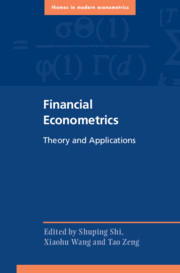Book contents
- Frontmatter
- Contents
- List of Contributors
- Foreword
- Acknowledgments
- Part I Trend Determination, Asset Price Bubbles, and Factor-Augmented Regressions
- 1 Asymptotics of Polynomial Time Trend Estimation and Hypothesis Testing under Rank Deficiency
- 2 Econometric Analysis of Asset Price Bubbles
- 3 Factor-Augmented Regressions and Their Applications to Financial Markets: A Selective Review
- Part II Continuous-Time Models and High-Frequency Financial Econometrics
- Part III Bayesian Estimation and Inferences
- Index
2 - Econometric Analysis of Asset Price Bubbles
from Part I - Trend Determination, Asset Price Bubbles, and Factor-Augmented Regressions
Published online by Cambridge University Press: 20 February 2025
- Frontmatter
- Contents
- List of Contributors
- Foreword
- Acknowledgments
- Part I Trend Determination, Asset Price Bubbles, and Factor-Augmented Regressions
- 1 Asymptotics of Polynomial Time Trend Estimation and Hypothesis Testing under Rank Deficiency
- 2 Econometric Analysis of Asset Price Bubbles
- 3 Factor-Augmented Regressions and Their Applications to Financial Markets: A Selective Review
- Part II Continuous-Time Models and High-Frequency Financial Econometrics
- Part III Bayesian Estimation and Inferences
- Index
Summary
In the presence of bubbles, asset prices consist of a fundamental and a component, with the bubble component following an explosive dynamic. The general idea for bubble identification is to apply explosive root tests to a proxy of the unobservable bubble. This chapter provides a theoretical framework that incorporates several definitions of bubbles (and fundamentals) and offers guidance for selecting proxies. For explosive root tests, we introduce the recursive evolving test of Phillips, Shi, and Yu (2015a,b) along with its asymptotic properties. This procedure can serve as a real-time monitoring device and has been shown to outperform several other tests. Like all other recursive testing procedures, the PSY algorithm faces the issue of multiplicity in testing. We propose a multiple-testing algorithm to determine appropriate test critical values and show its satisfactory performance in finite samples by simulations. To illustrate, we conduct a pseudo real-time bubble monitoring exercise in the S&P 500 stock market from January 1990 to June 2020. The empirical results reveal the importance of using a good proxy for bubbles and addressing the multiplicity issue.
Keywords
- Type
- Chapter
- Information
- Financial EconometricsTheory and Applications, pp. 30 - 59Publisher: Cambridge University PressPrint publication year: 2025

